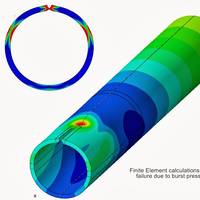Pipeline Damage Assessment Tool Launched

Tecnitas, the marine advisory arm of leading international classification and verification group Bureau Veritas (BV), has launched a new technology simulation system for pipeline damage assessment, in collaboration with Total. This system, EMPREINTE, helps pipeline operators to determine safe operating pressures after a pipeline is damaged. It is a software suite which provides a decision making tool which, according to BV, aims to save operators money and cut downtime for pipeline repairs.
FE Modelling Under Discussion
Forum "Finite Element Modelling of Ships". held in the headquarters of Germanischer Lloyd (GL) in Hamburg, Germany. more than 30 years, modelling is still a current topic. minimal utilisation of already existing CAD data. (FE). facilitate the direct use of the CAD data for the global FE modelling. of the ship design process with TKMS. discussion about finding an efficient analysis procedure. FE-models. vertical and longitudinal strength in moment and shear force. Germanischer Lloyd. Wilken who also showed ways to handle these conflicts. GL ShipModel. processor for CAE simulation. tankers, naval vessels, ferries and motor yachts. structural. way. Vibration Results based on early and late Stage Finite Element Models. Dr. multi-disciplinary requirements.
Current Uses of FEA in Shipbuilding
By Tony Abbey, Technical Manager, Noran Engineering, Inc. Finite Element Analysis (FEA) was developed in the Aircraft Industry in the late 1950's as a way of handling the more complex structures that were evolving. Finite Element analysis has been used in the maritime industry for many years. Lloyds Register and other certification authorities were very early adopters of the technique. The NASTRAN FEA code was developed by NASA in the early 1960's to standardize FEA methods across contractors for the major Aerospace projects such as the Moon program and F-111. It was commercialized in the early 1980's. NE NASTRAN was introduced in the mid 1990's with the emphasis on the PC environment to avoid the expense of the mainframe computing bottlenecks that many large contractors were experiencing.





